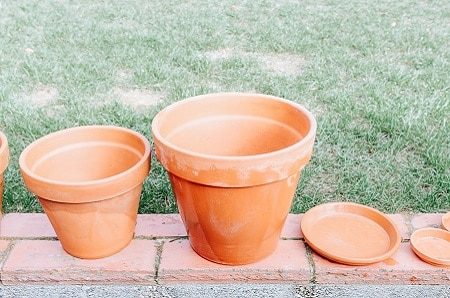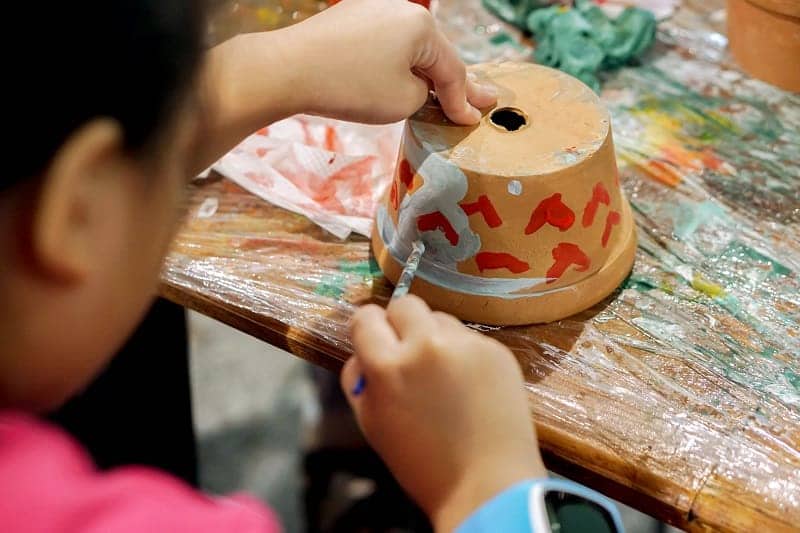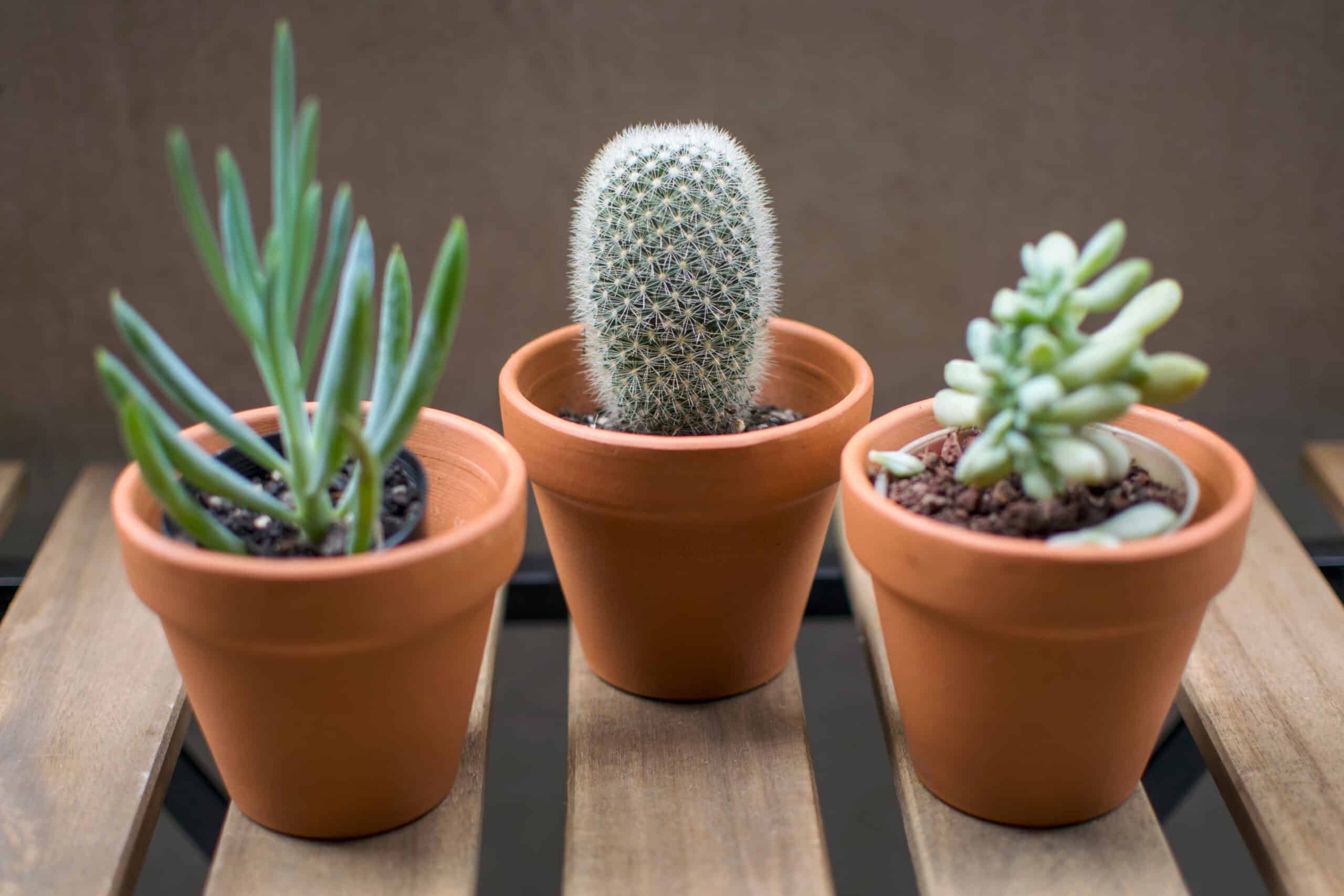
Terracotta pots are one of the most popular types of containers for succulents. They’re famously inexpensive and their classic earthy red coloring works well with nearly any color palette. The only downside of terracotta pots is that they’re a little… well, boring.
Planting your succulents in vibrant containers is a fun way to add a splash of color to your garden, so why not spice up your boring terracotta pots with a coat of paint?
Jump to:
What Kind of Paint to Use

When painting your terracotta pots, you want to make sure you do it right the first time. That way, your incredible paint job will last, and you won’t find yourself redoing your pots a few months down the road. With the right type of paint, you’ll be able to enjoy your colorful containers for years to come.
Acrylic paint is typically the most popular choice for painting terracotta pots. It’s highly pigmented, which means you’ll be able to enjoy bright colors without having to do too many layers of paint. Acrylic paint tends to be quite thick, so it’s ideal for painting designs without worrying about your paint dripping or running down the side of your pot.
You can find acrylic paint in a wide variety of colors at your local art supply or craft store. Whether you’re looking for pastel color, a metallic finish, or something with a little glitter, you should be able to find an acrylic paint to suit your needs.
Additionally, acrylic paint tends to be quite inexpensive, so you won’t need to break the bank to spice up your succulent garden. If you plan on painting quite a few terracotta pots, you may need to buy a few different bottles or tubes of paint, so plan accordingly.
You can also try painting your terracotta pots with latex paint. Latex paint is typically used for painting houses, both indoors and out. Using latex paint intended for outdoor use can help ensure that your artwork stays in place no matter the weather.
Like acrylic, latex paint is available in a nearly endless variety of colors and finishes. You should be able to find it at your local home improvement store. Latex paint is also fairly budget-friendly, but you’ll probably find yourself buying more paint at a time than you would with acrylics. However, if you plan on painting more than a few pots, a can of paint might be just the way to go.
What Kind of Brushes to Use

The type of brush you use to paint your terracotta pots will depend on what type of design you plan on doing. If you’re just looking for coverage, a wide bristled or foam brush will work well. On the other hand, if you’d like to add intricate patterns to your paint job, you’ll need a brush small enough for detail work.
While a paint roller might cover a wall with paint quickly, it might be best to avoid this type of brush when painting planters. You’ll likely spend more time cleaning up your mess than you would save using such a wide brush anyway.
If you plan on using several different colors of paint, you may want to consider buying more than one paintbrush. Having a separate brush for each color will ensure that you don’t accidentally mix your colors and you won’t spend so much time cleaning brushes.
To Prime or Not to Prime?
If you’ve done much painting in the past, you may be wondering if you should be using a primer on your pot before you paint. The short answer is: it’s up to you. There are a couple of different factors to consider when deciding whether you should prime your pots.
First, there are actually products on the market specifically designed for sealing clay pots. Using a sealant will not only weatherproof your pot, but can help your paint job last longer.
No products found.
The downside to using sealants is that they will affect the breathability of your pot. One of the benefits of using terracotta pots is their ability to absorb excess water. If you seal your pot, it’s going to lose its ability to get rid of excess moisture, so you’ll need to be more careful about watering your plants.
However, if you choose to use a water-based paint primer instead of a clay pot sealant, your pot will be able to breathe a bit better. You may lose some breathability, but not as much as if you had completely sealed the pot.
A paint primer will also help your paint job pop, so if you’re using bright colors, consider using a white primer before painting. The white base layer will help the colors of your paint appear more vibrant than if you had painted directly onto the terracotta surface.
You also have the choice of not using a primer at all. Not using a primer means your pot will be able to continue absorbing excess moisture. Just be aware that over time, your paint job may suffer a bit. If you don’t mind an aged or rustic appearance, not using a primer may be your best option.
Preparing Your Pots

Regardless of whether you’re using brand new pots or repurposing previously used pots, you’ll want to thoroughly clean them before you use them. Removing excess dust and dirt will give the paint a clean surface to adhere to, resulting in a better paint job.
To clean your terracotta pots, run them underwater, and gently scrub them with a bristled cleaning brush or sponge. If your pots are especially dirty, it may take a bit of elbow grease to get them clean, but the cleaner you get them the smoother your paint will go on.
After cleaning, you’ll need to let your pots dry completely. This can take some time, especially in cooler weather, so be prepared to set your pots aside for a day or two if needed. They need to be COMPLETELY dry before you can apply your primer, sealant, or paint.
The same rule applies after you’ve applied your primer or sealant. Make sure it’s completely dry before applying your first coat of paint.
Painting Your Pots

Now that your pots are dry, it’s time to paint! It can be helpful to lay out a drop cloth or newspaper on your table or desk to help contain the mess, so prepare your work area as needed.
The next step is up to you. Paint your pots however you like. Solid colors, interesting patterns, and intricate designs are all fun options!
If you’re using more than one color of acrylic paint on your pots, consider using a paper or plastic plate as a palette so that you can have each color available to you when you need it. That way, you won’t be wasting time squeezing small amounts of paint out when you need them. Latex paint tends to be too runny to use this way, but using small cups or containers works well for keeping colors separated.
If you need help with your design, you can use painter’s tape to help with straight lines or patterns. You can also use stamps, fabric, leaves, or other tools to create interesting patterns and textures in your paint.
If you need to do more than one coat of paint or plan on layering your colors, be sure to let each coat dry completely before moving on to the next. Unfortunately, painting terracotta pots requires a bit of patience, but the crisp lines and vibrant colors will be worth the wait.
Sealing Your Pots After Painting
After you’ve painted your terracotta pots with your own unique and interesting designs, you’ll need to wait for the paint to dry before deciding on the next step. Again, this may mean waiting a few hours or even an entire day, depending on how warm it is in your workspace and the type of paint you’ve chosen to use.
Once the paint has dried completely, you’ll need to decide whether you want to finish your pot with a coat of glaze or sealant. This step isn’t necessary, but it can help protect your artwork from the elements and wear and tear of everyday garden life.
You can seal your pots with spray shellac, clear acrylic sealer, or clear lacquer, whichever you choose. Consider using a spray, rather than a paint-on sealer as it won’t cause your paint job to smudge or drip.
You should be able to find an appropriate product at your local home improvement, art supply, or craft store. Sealers and lacquers are often available in a variety of finishes from matte to high gloss, so you can choose according to the look you’d like to achieve. High gloss finishes will have the effect of glazed ceramic pots, while matte finishes will be a bit more subdued.
Depending on the type of sealer you use, you may need to apply two or three coats. Again, you’ll need to wait patiently for each layer to dry before moving on to the next. Don’t worry, your patience will be worth it when you see how fabulous the finished product is!
What You Need to Know About Terracotta Pots

Terracotta pots are often the pot of choice amongst professional and home gardeners. Many people like to keep them rustic and natural-looking, while others prefer to jazz up their appearance with a lick of paint.
The main reason gardening enthusiasts choose to plant their plats in terracotta pots is due to their ability to allow air and water to flow through them freely. This prevents root rot and other not-so-ideal conditions like soil disease that could kill your plant.
Have you ever looked at the bottom of a terracotta pot? They have drainage holes that remove excess water from the pot entirely, and most pots come with a saucepan that collects the excess water at the bottom.
These posts are also super inexpensive, so gardeners like to opt for these pots. Painting terracotta pots are far more cost-effective than buying fancy pots, all while looking just as striking!
Handle them With Care
Yes, terracotta pots can be used indoors and outdoors, and the pros of opting for terracotta pots outweigh the negatives in a lot of ways, but there are a few things to remember when handling them. These pots will crack and break easily, especially when they are handled in cold weather, so make sure that you are always extra careful with them.
Terracotta Pots vs. Clay Pots
Terracotta and clay pots look very similar, and they are both popular options as house and garden plant containers. Let’s take a look at some of the differences between terracotta and clay pots in the following section.
1.Color
The biggest giveaway is a pot’s color. Terracotta pots are often a rusty red color or an orangy brown tone, whereas clay pots can come in every color. Terracotta pots are always their classic rusty tone, so if you are looking at a colorful pot that feels like a terracotta pot, it is probably clay or ceramic.
2. Glazing
Here is a big telltale sign. Terracotta pots are never glazed, whereas clay pots are usually finished with a glaze to make them look more polished and refined.
3. Baking Process
Clay pots are baked at a lower heat than terracotta pots. Ok, this might be very hard to see visually, but you can look out for black burn marks on the bottom of clay pots if you want to spot signs of the making process.
Terracotta Pot FAQ:
You should feel like a terracotta pot painting expert now that you have read this guide, but don’t worry if you still have some questions that you need answering regarding terracotta pots. This frequently asked questions section should help you.
Q: Why do I need to soak terracotta pots before using them?
A: Soaking your terracotta pots before using them will stop the pot from soaking up all of your plant’s water. Terracotta is very porous, so a dry pot will be thirsty for that extra moisture.
Q: Should I line my terracotta pot?
A: Lining terracotta pots could prologue the life of the pot, but it might not be the best solution for your plant. Terracotta pots are incredibly porous, which is what plant growers love about these pots the most, so lining them will only tram water around the root system.
Q: Why are my terracotta pots turning white?
A: Terracotta pots are very porous, so the vitamins and minerals in the water flow through the soil to the walls of the pot and out. This causes a white powder to form on the outside of the pot. If you do not like the look of this, you can always paint your pot!
Q: Why are terracotta pots got for cacti and succulents?
A: Terracotta pots naturally pull the water from the soil and into the pot, which is perfect for plants that require infrequent watering.
Q: How can I age my terracotta pots quickly?
A: Using clay soil, yogurt, moss, buttermilk, or fertilizer will age your terracotta pots in no time. This is a fast and easy aging method for anyone searching for a rustic-looking terracotta pot on a budget.
Q: How can I keep my terracotta pots looking clean and new?
A: Terracotta pots age beautifully. Their color changes in areas over time, and dirt and grime almost look like an intentional accessory. If this is something that you want to avoid, think about pressure washing your pots frequently.
Q: Can terracotta pots get water damaged?
A: Yes, excess water will damage your terracotta pot, causing it to crumble or crack under the slightest pressure.
Q: What kind of paint should I use to paint my terracotta pot?
A: Acrylic paint is the best paint to use on terracotta pots. You need to make sure that you seal the paint with a sealer once you finish painting.



Connie
Can you please send me the name of the sealant you used for the terracotta pots. Also, how long is it OK to wait before sealing the pot? I will be painting pots tomorrow but won't be able to seal until next week.
Thank you,
Connie
Patrick Grubbs
Hey Connie! Any sealant works, really, because acrylic paint isn't too hard to bond to. I use whatever I have on hand - I like polyurethane spray. You can seal it any time after the paint has dried - the only reason you might want to rush is so that the paint doesn't accidentally get damaged in the meanwhile.
Caitlin
If you decide to seal your paint job after it is dry, do you have to worry about the absorbency of the clay - like with primer?